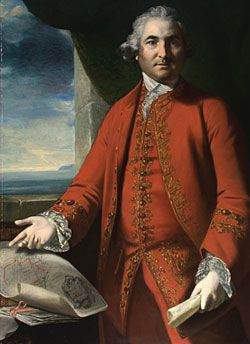My Cart
Your Shopping Cart is currently empty. Use Quick Order or Search to quickly add items to your order!
Kristin Wustholz
Assistant Professor of Chemistry
The College of William & Mary
What does nanotechnology have to do with art? Although these fields may seem quite dissimilar, nanotechnology and art have been united since antiquity. For example, silver and gold nanoparticles imbue color to The Lycurgus Cup, an important art object that depicts a Roman mythological scene and dates to the 4th century AD. As the field of nanotechnology continues to develop and nanostructures become more easily and reproducibly fabricated, there is concomitant interest in using nanotechnology for real-world applications such as art conservation.

|
Portrait of Isaac Barré by Sir Joshua Reynolds |
One of the major challenges in art conservation is the ultrasensitive and unambiguous detection of natural, organic colorants in paintings. Colorants derived from plant and animal sources (such as indigo, carmine lake, and madder lake) are prone to fade upon exposure to light. Thus, the identification of these "fugitive" colorants is exceedingly important for the long-term preservation of artworks as well as for enhancing our understanding of their historical context. My new collaboration with Shelley Svoboda, paintings conservator at the Colonial Williamsburg Foundation, has enabled the development of new nanotechnology-based methods to detect fugitive colorants in oil paintings.
Our collaborative team focuses on the examination of oil paintings from the Colonial era, where fading colorants such as indigo and carmine lake are thought to contribute to the complex chemistry of paint. To perform a chemical analysis on incredibly small samples (invisible to the human eye), Svoboda uses a surgical blade to carefully remove single pigment grains from a painting under a microscope. The microscopic samples then receive an application of small quantities of silver nanoparticles. These steps were followed for two 18th-century oil paintings: Portrait of Isaac Barré by Sir Joshua Reynolds and Portrait of William Nelson by Robert Feke. We used a laser to illuminate the resulting nano-treated samples in a technique termed surface-enhanced Raman scattering (SERS). In SERS, metal nanostructures act as antennae to concentrate and broadcast the unique spectroscopic signal of the colorants. SERS studies of the flesh tones from these portraits revealed the presence of carmine lake, a costly red pigment made from crushed cochineal insects.1 The fact that Feke, the earliest native-born American artist, used carmine lake during the Colonial period is surprising and suggests that a Colonial apothecary could have been a source of the high-priced colorant.
Although SERS studies of paintings are straightforward in many circumstances and do not require pretreating the art sample, our team discovered this is not always the case. Indeed, the important blue colorants indigo and Prussian blue could not be detected using the silver nanoparticles and SERS approach unless samples were first pretreated with sulfuric acid. For example, a microscopic H2SO4-treated sample from the Portrait of Evelyn Byrd produced a SERS spectrum that is consistent with a mixture of Prussian blue and indigo—the first simultaneous detection of blue organic and inorganic colorants in paint using SERS.2 Although this emerging tool in nanotechnology has proven effective for several colorants, SERS has a long road ahead toward becoming a broad-spectrum technique that is capable of measuring a wide variety of artists' materials in the museum setting. Toward this end, Svoboda and I are now working together to identify colorants in Colonial Williamsburg's collection of oil paintings and other art objects—as well as improving the nanoparticle substrates themselves.